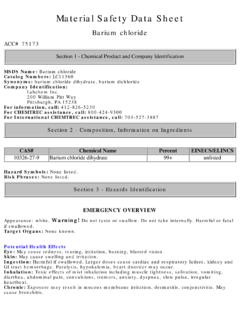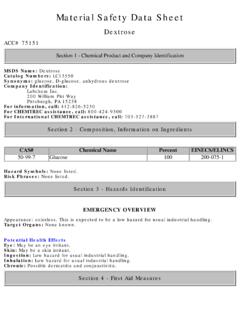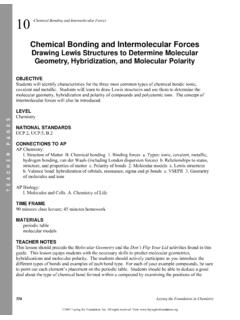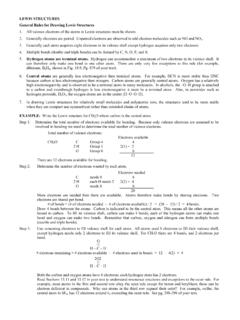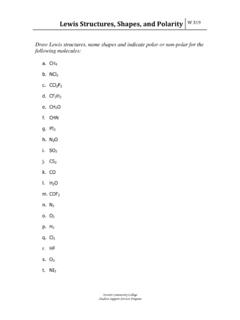Transcription of Narrative Elements Explained - Lewis University
1 Narrative Elements Explained The purpose of this resource is to assist in the critical reading of narratives, and to help students explore how the effect is created and meaning is made. Fiction is best understood by breaking down and discussing terms common to most stories, be they novels, short fiction, movies, TV shows, etc. These terms include: plot, characters, point of view, setting, theme, conflict, and style. Understanding how these Elements work helps us better analyze narratives and to determine meanings. Seven main Elements of fiction are defined below followed by a sample of questions to help readers uncover meaning of a given Narrative . Theme Definition: Theme is perhaps the most important literary concept because it is the overarching idea that the writer of the story wants to reader to understand.
2 All other literary concepts are used to create theme. The theme is the author's commentary on a subject. For example, in Shakespeare's Othello, one of the major themes is how easily human perception can be manipulated when powerful emotions are at play. To determine the theme, examine other literary Elements of the story. Questions to Consider: First identify the subject (s) of the story and then ask: what is the writer trying to say about this subject? What literary tools does the writer use to create this theme? Plot Definition: Plot is the structure of the Narrative as it moves through time. Most narratives (but not all) follow this traditional plot structure. It consists of the exposition (introduction of setting and characters), rising action (events that build conflict for the protagonist), climax (tension of conflict reaches highest, most intense point), falling action (the events following the climax), and denouement (the resolution of conflict).
3 Questions to Consider: What is the relationship between the events of the story? How do the actions inform the theme of the story? Characters Definition: Characters are the people involved in the Narrative . The process by which a writer creates a character is called characterization. The main or central character, often considered the hero, is called the protagonist. The main character who opposes the protagonist is the antagonist, sometimes considered the villain. Literary analysis of characters often focuses on whether or not and to what extent a character changes throughout the story. Questions to Consider: What is the motivation of each character? How do characters grow or transform throughout the story? Or do they fail to grow or change at all?
4 What does their growth or lack of growth say about the theme of the story? Conflict Definition: Conflict refers to the issue or problem characters in a story are confronted by. The Narrative is structured around how the characters face the conflict. The four general types of conflicts are: 1) person vs. person (a couple going through a divorce); 2) person vs. self (protagonist wrestling with depression); 3) person vs. nature (protagonist trying to survive a natural disaster); and 4) person vs. society (protagonist fighting for civil rights). The interaction of character and conflict creates the central effect of the story and is the main indicator of meaning. Questions to Consider: How does the conflict affect the main characters in the story?
5 How is the conflict resolve d and what does the resolution say about theme? How does the conflict change the main characters? Setting Definition: This element can refer to a time and place the story is set in. The location can either work symbolically or it can simply be a backdrop for the story to take place in. Questions to Consider: How does the location, time, and/or date of the story affect the theme? How does the setting affect how the characters respond to conflict? Point of View Definition: Refers to the perspective the story is told from. This element includes first-person, third- person, and third-person omniscient narrators. * First-person narrator: Tells the story from the perspective of one or several characters with the word I or we.
6 The readers, as if from their own eyes, can envision the characters actions. * Third-person limited narrator: Tells the story from an outside perspective from the perspective of one of the characters (usually the protagonist). The third-person limited narrator can relate events, thoughts, actions, but is limited to that single character. For example, if the narration is from the point of view of the protagonist, the narrator cannot relate events that are happening across town from where the protagonist is, nor can they relate the interior thoughts of any other character. Third person limited narration uses the pronouns he, she, or they.. * Third-person omniscient narrator: Also tells the story from an outside perspective but this narrator is not limited to actions and thoughts of one character.
7 This narrator knows all of the in formation of the story and can relate the events of the story, the actions and speech of each as well as the interior thoughts of any character. There are no limits for this narrator. Questions to Consider: Does the narrator reflect an inner or an outer perspective on the stor y? Why did the author select this point of view? What would change if the story were told from a different point of view? Style Definition: This element refers to the way the writer uses language including diction, voice, tone, sentence style, etc. Paying attention to these details allows the reader to identify how and why word choice and sentence style, etc. can help create the effect and meaning of the story. Questions to Consider: Is the diction hard or simple to understand?
8 Are the sentences short or complex? Why did the writer make these stylistic choices? How do these choices add or detract from the effect of the story? NOTE: Of cour se, these ar en 't the only literary devices Narrative writers use to create their stories. Imagery, symbolism, metaphor, foreshadowing, and ambiguity, for example, are other important devices that should also be considered in the analysis of narratives. Further Assistance: For m or e detailed help or if you h ave questions, visit th e W riting Center located in the Lewis University Library or call 815-836-5427. Sources Consulted: Pur due Ow l, Writing About Literature by Janet E. Gardner, Fiction and Drama by Dr. Jackie Whit

